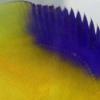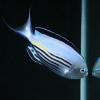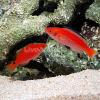-
Posts
16,553 -
Joined
-
Last visited
-
Days Won
29
Content Type
Profiles
Forums
Gallery
Everything posted by yikai
-

what happening for maroon clown
yikai replied to zebradanio's topic in Disease treatment/parasite/pest control
most probably brooklynellosis. very common in clownfish especially wild caught clowns. is there a slimy layer on the fish? -

OMG! Look at these hybrids and rare fishes!
yikai replied to Digiman's topic in FOWLR (Fish-only with Live-rock)
thank you! simply amazing genus. this is my current obsession. i MUST obtain the males of bellus and semifasciatus. bellus is freaking beautiful with two horizontal yellow lines. semifasciatus is just gorgeous with it's yellow mask. -

OMG! Look at these hybrids and rare fishes!
yikai replied to Digiman's topic in FOWLR (Fish-only with Live-rock)
There are a total of 10 species in the genus Genicanthus aka swallowtail angels. the name comes from their extremely enmarginated tails which are deeply lunated. 4 of which are unobtainable. the unobtainable ones are - Genicanthus semicinctus (Found only on Lord Howe Island and kermadec islands) - Genicanthus takeuchii (Found only in Chichi island in Ogasawara, and Marcus island) - Genicanthus personatus (Found only in hawaii islands and midway atoll. It's obtainable if you are filthy rich) - Genicanthus spinus (Found only in cook islands, pitcairn, and austral island) These below are the 6 obtainable Genicanthus. In order of pictures, G. semifasciatus, G. melanospilos, G. bellus, G. lamarck, G. caudovittatus and G. watanabei. Pics here shown are all males. of all 6, semifasciatus and bellus are my favourite. this 2 are a MUST obtain for me. males of all species are very rare, with an exception of melanospilos and lamarck. which are very common. -

WEEKLY UPDATE - 12TH TO 18TH JULY 2010
yikai replied to iskay's topic in Weekly LFS Stocks Report / LFS Info Centre
also 2 large female genicanthus bellus. aka the bellus or the ornate angelfish. buying both and adding them together will enable one to turn male, provided they don't fight. the genus genicanthus (swallowtail angelfishes), are very beautiful and very very very reefsafe (there are freak exceptions). males of this genus are very very uncommon and very difficult to acclimate. females are common and less colourful. -

OMG! Look at these hybrids and rare fishes!
yikai replied to Digiman's topic in FOWLR (Fish-only with Live-rock)
this fish should be extinct. it's too big, fierce and ugly. -

WEEKLY UPDATE - 12TH TO 18TH JULY 2010
yikai replied to iskay's topic in Weekly LFS Stocks Report / LFS Info Centre
Do not confuse the angelfish above with this angelfish. Genicanthus melanospilos. this is very common and found very easily. CF has a magnificent pair, one male and one female. and also a single male. how to differentiate? females are very different of these two species. but the males are similar. G. melanospilos has a black dot on it's breast while G. caudovittatus does not. G. melanospilos also lacks the thick black line on the dorsal fin which G. cuadovittatus posesses. anyway let's not off topic. -

WEEKLY UPDATE - 12TH TO 18TH JULY 2010
yikai replied to iskay's topic in Weekly LFS Stocks Report / LFS Info Centre
first picture of a male, second picture is the female of Genicanthus caudovittatus the one available in CF is female. if you have the patience, you can make it morph into a male by pitting it's aggression against other smaller genicanthus sp. -

brown powder algae on sand bed
yikai replied to ashaegyee's topic in New to the Marine Aquaria Hobby
if it appears if your tank is very new, it's new tank syndrome. can't do anything about it. let it grow and die off naturally. -

OMG! Look at these hybrids and rare fishes!
yikai replied to Digiman's topic in FOWLR (Fish-only with Live-rock)
digi, i'm sad to say i failed to find that common chromis at LCK. zzz -

OMG! Look at these hybrids and rare fishes!
yikai replied to Digiman's topic in FOWLR (Fish-only with Live-rock)
-

OMG! Look at these hybrids and rare fishes!
yikai replied to Digiman's topic in FOWLR (Fish-only with Live-rock)
three species of beautiful chromises that look very similar. in order of pictures from left to right, chromis acares, chromic vanderbilti, chromis lineata -
tangs need algae. majority of people do not know that tangs are herbivorous in the wild. they eat mainly algae and occasionally some invertebrates. just because they eat mysis, brine etc does not mean they are happy. they still need their algae. nori, macroalgae etc are excellent sources of algae.
-
Check them out. feeding from the surface. god like amazingness. http://reefbuilders.com/2010/07/16/captive-bred-mandarin-feeding-video/
-
omg. maybe it will show two of the rarest deepwater fishes ever. the centropyge abei (abei's dwarf angelfish), and the chromis abyssus (abyssal chromis)
-

OMG! Look at these hybrids and rare fishes!
yikai replied to Digiman's topic in FOWLR (Fish-only with Live-rock)
i want a pair too. a pair of males or females, whatever. don't like keeping wrasses solitarily. -
galaxy corals tolerate high flow VERY well. they are found in very turbid waters with high surge zones. their sweeper tentacles can extend 2x their length in high flow, as what bro ingwe experienced. So take caution.
-

WEEKLY UPDATE - 12TH TO 18TH JULY 2010
yikai replied to iskay's topic in Weekly LFS Stocks Report / LFS Info Centre
Marjories in LCK were in excellent condition. The biggest one was very nice but looked quite stressed. the other 3 were in the pink of health. *picture of marjorie fairy wrasse below Kudos for steven in LCK for being the first person in Singapore to import this very rare fijian endemic. We certainly hope to see more of these wrasses in the future. still have many rhomboids, tail spot blennies, Cirrhilabrus condei, cortez lunar wrasse, etc.. CF has a very uncommon female Genicanthus caudovittatus. A swallowtail angel appearing only from the region of Red sea and is very uncommon. This is my first time seeing this fish here. Too bad it wasn't a male otherwise would have bought it. To the untrained eyes, males of this species look very similar to the super common male Genicanthus melanospilos. The former being much rarer and much nicer. -

OMG! Look at these hybrids and rare fishes!
yikai replied to Digiman's topic in FOWLR (Fish-only with Live-rock)
For the first time ever, 4 Cirrhilabrus marjorie made it to Singapore via LCK. we should be happy that such rarities are finally entering our small market. I got 1, digiman got 2, and LaW got 1. Cirrhilabrus marjorie was founded in Fiji by Bruce Carlson (if i'm not wrong, his sur name is carlson). He thought that it was such a beautiful fish that he had to name it after his wife, Marj. Thus the species name marjorie. It is a fijian endemic and found only in Fiji, in isolated parts. Very rare and considered one of the Holy grails. I've waited far too long and finally obtained one. Let's hope that more of these wrasses appear in the near future. -

OMG! Look at these hybrids and rare fishes!
yikai replied to Digiman's topic in FOWLR (Fish-only with Live-rock)
males i dunno. but u sure u din mix up semifasciatus with melanospilos? the females look very similar. anyway it's always been rare in the states. i've never seen them everywhere here. only once. last year. -

OMG! Look at these hybrids and rare fishes!
yikai replied to Digiman's topic in FOWLR (Fish-only with Live-rock)
but yellow mask is so rare.. -

OMG! Look at these hybrids and rare fishes!
yikai replied to Digiman's topic in FOWLR (Fish-only with Live-rock)
very ugly. i want the first one. -

OMG! Look at these hybrids and rare fishes!
yikai replied to Digiman's topic in FOWLR (Fish-only with Live-rock)
-

OMG! Look at these hybrids and rare fishes!
yikai replied to Digiman's topic in FOWLR (Fish-only with Live-rock)
-

OMG! Look at these hybrids and rare fishes!
yikai replied to Digiman's topic in FOWLR (Fish-only with Live-rock)






















